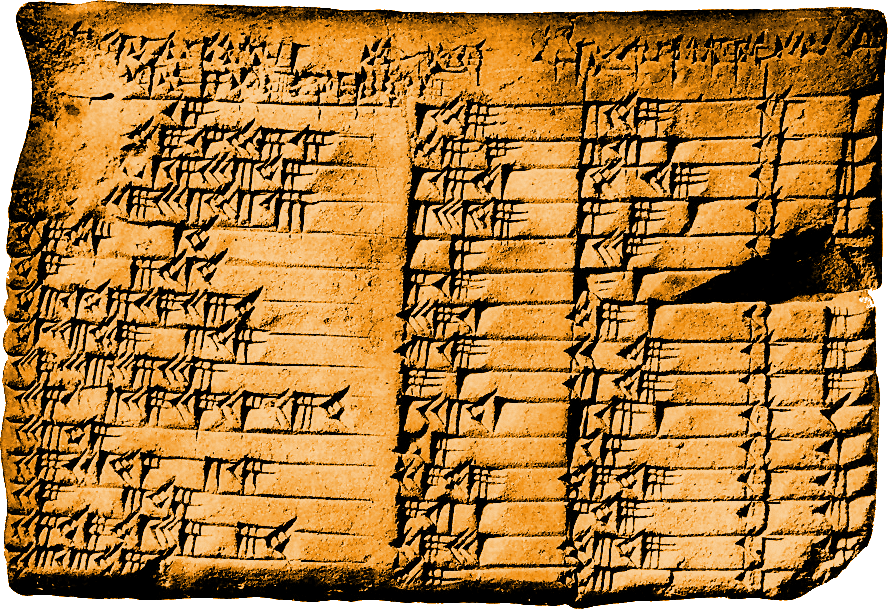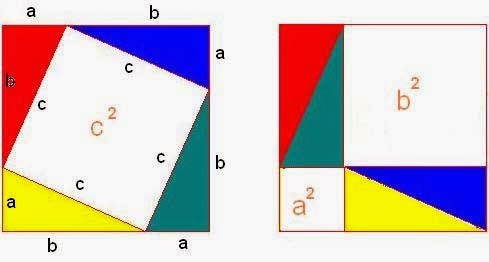
Pythagoras was a Greek philosopher who is said to have lived around 500 BC, and is credited by most western educational institutions with the development of what they call the Pythagorean Theorem, the mathematic equation which expresses the relationship between the sides of a right triangle; where the square of the hypotenuse of the triangle is equal to the sum of the squares of the other two sides of the triangle. The Pythagorean Theorem is also known as the 47th Problem of Euclid, because Euclid, who is said to have lived several hundred years after Pythagoras, and is called the “father of Geometry” by western educational institutions, worked on solving the ratio 3:4:5 Pythagorean triple. If the first 5 numbers 1,2,3,4,5 are squared to yield 1,4,9,16, and 25, then subtracting each square from the next yields the sequence 1,3,5,7,9…

However, it has long been suspected that this theorem, and the proof of this theorem, existed thousands of years before Pythagoras is said to have been born.
Evidence that the Babylonians had knowledge of Pythagorean Triples is available on the artifact known as Plimpton 322, which contains tables inscribed with Pythagorean Triples.

In his collection of essays entitled “Moralia Volume 5”, the Greek essayist Plutarch comments on the Ancient Egyptian’s knowledge of the 3:4:5 Pythagorean triple and its relationship between the sides of a right triangle expressed in Ancient Egyptian symbolism by saying:
“The upright, therefore, may be likened to the male, the base to the female, and the hypotenuse to the child of both, and so Ausar may be regarded as the origin, Auset as the recipient, and Heru as perfected result. 3 is the first perfect odd number, 4 is a square whose side is the even number 2, but 5 is in some ways like its father and in some ways like its mother, being made up of 3 and 2...”
In the book entitled “The Pythagorean Theorem: The Story of Its Power and Beauty”, by Alfred Posamentier, he states:
“The Pythagorean Theorem was known long before Pythagoras, but Pythagoras is attributed as the first to prove it.”
However, in the book “Stolen Legacy” by George G.M. James, it is argued that Pythagoras was shown proof of the theorem by the Ancient Egyptians. It states:
“Pythagoras travelled to Egypt and was taught geometry by the Egyptian Priests and made to sacrifice to the Gods, before they showed him the proof of the theorem of the square on the hypotenuse of a right angled triangle. Pythagoras did not discover this proof, and it is misleading to name the theorem after him.”
The book “Stolen Legacy” also states:
“… we have the statements of Plutarch, Demetrius and Antisthenes that Pythagoras founded the Science of Mathematics among the Greeks, and that he sacrificed to the Muses, when the Egyptian Priests explained to him the properties of the right angled triangle. Pythagoras was also trained in music by the Egyptian priests.”
The proof attributed to Pythagoras is very simple, and is called a proof by rearrangement. The two large squares shown in the figure each contain four identical triangles, and the only difference between the two large squares is that the triangles are arranged differently. Therefore, the white space within each of the two large squares must have equal area. The triangle in figure 1 can be rearranged to create figure 2, and equating the area of the white space yields the proof attributed to Pythagoras.

So, is there any evidence that a proof by rearrangement for this theorem is available in Ancient Egypt? Well, since we are talking about triangles, let us look to the pyramids of Giza, the three giant triangular structures built by the Ancient Africans in Egypt 2000 years before Pythagoras was said to have been born. From above, if we rearrange the pyramids of Giza, we see evidence of the proof of the theorem.
%2BTheorem%2Bcopy.png)
The base of Menkaure’s Pyramid is 51.7 cubits, the base of Khafre’s pyramid is 107.6 cubits, and the base of Khufu’s pyramids is 115.2 cubits. Plugging into the equation, we see that the mathematical result (119.4) is a statistically significant reasonable approximation, a difference of 4.2 cubits, less than 4% error (3.5%). Considering that the outer casing of the Giza pyramids have been removed, and the wear and tear on the pyramids over the thousands of years, this may account for the discrepancy.
Given this evidence, it does not seem right to use the term “Pythagorean Theorem” for a concept which existed thousands of years before Pythagoras. In the book Stolen Legacy, Dr. George G.M. James suggests that “The name of Pythagoras… should be deleted from our mathematical textbooks: in Geometry, where the theorem of the square on the hypotenuse of a right angled triangle is called the Pythagorean theorem, because this is not true.”
So what term can we use to replace the term “Pythagorean Theorem”? We can see the civil engineers and architects of the Giza complex built the proof of the theorem into the design of the Pyramid complex at Giza. So the term we use as a replacement for the term “Pythagorean Theorem” should pay homage to the African Pyramid builders, architects, and engineers. Dr. Kaba Kamene (Dr. Booker T. Coleman) suggests that the name “Pythagoras” comes from a Greek amalgamation of the names of African Egyptian deities Ptah and Horus (Heru). Interestingly enough, the deities Ptah and Horus were patron deities of the Ancient African Pyramid builders, architects, and engineers. Ptah was a patron deity of builders and craftsmen, and Horus as Heru-Behutet was a patron deity of blacksmiths and workers in metal, The Great Chiefs of the Hammer.
Additionally, Ptah and Ausar were combined in Egyptian Mythology, and both Ptah as Ausar, and Horus are present as the upright and hypotenuse of the 3-4-5 right triangle ratio represented by Ausar, Aset, and Heru respectively.

Considering the aforementioned phonetic and symbolic relationships of Ptah and Horus to “Pythagoras”, then the proposition is put forth that the Pythagorean Theorem should henceforth and forever be known as the Ptah-Horus Theorem.
African Creation Energy: The Ptah-Horus (Pythagoras) Theorem – The African Origin of the Pythagorean Theorem
